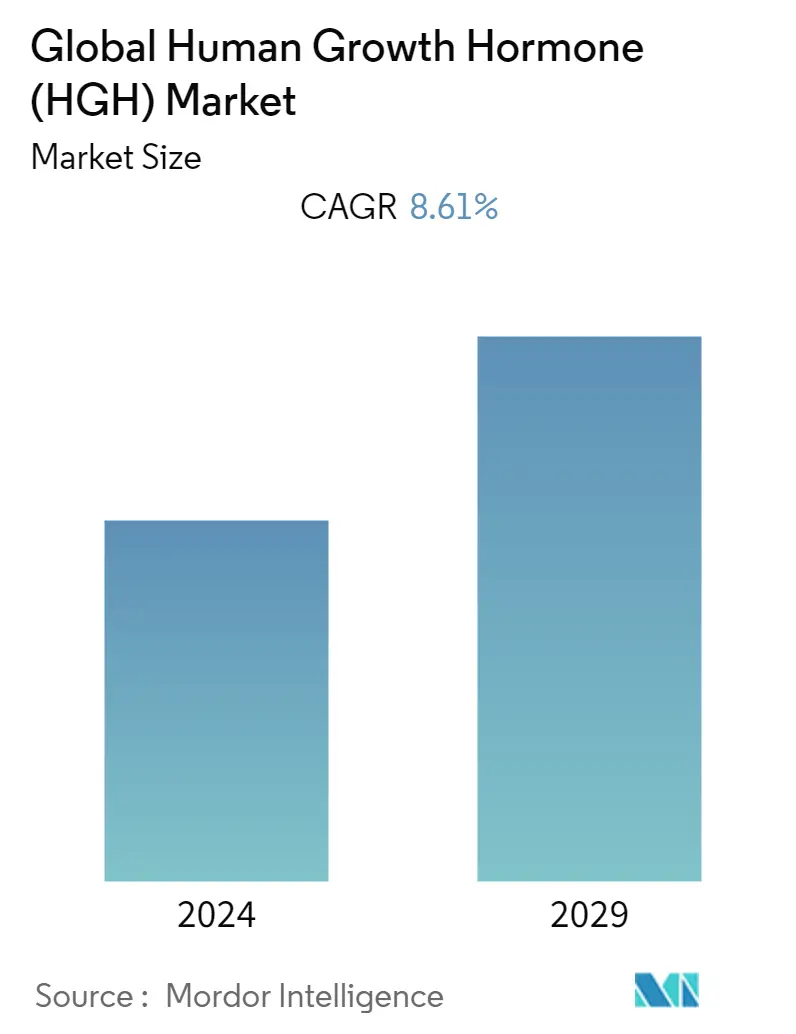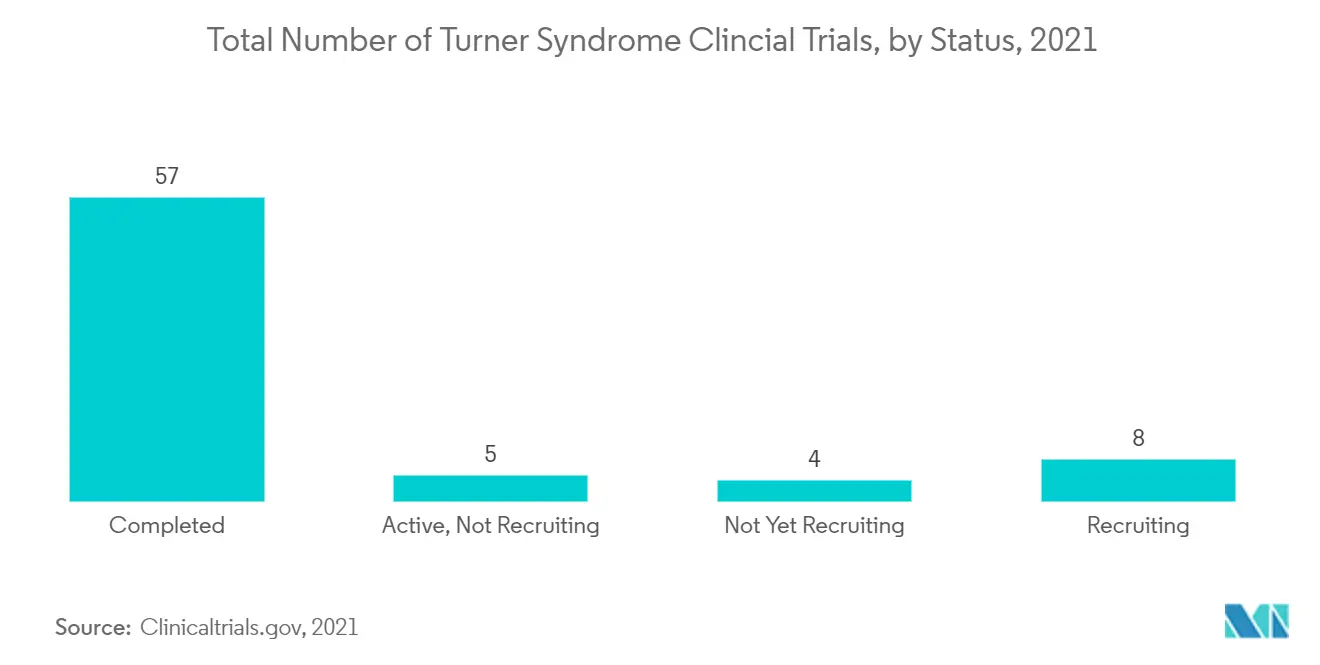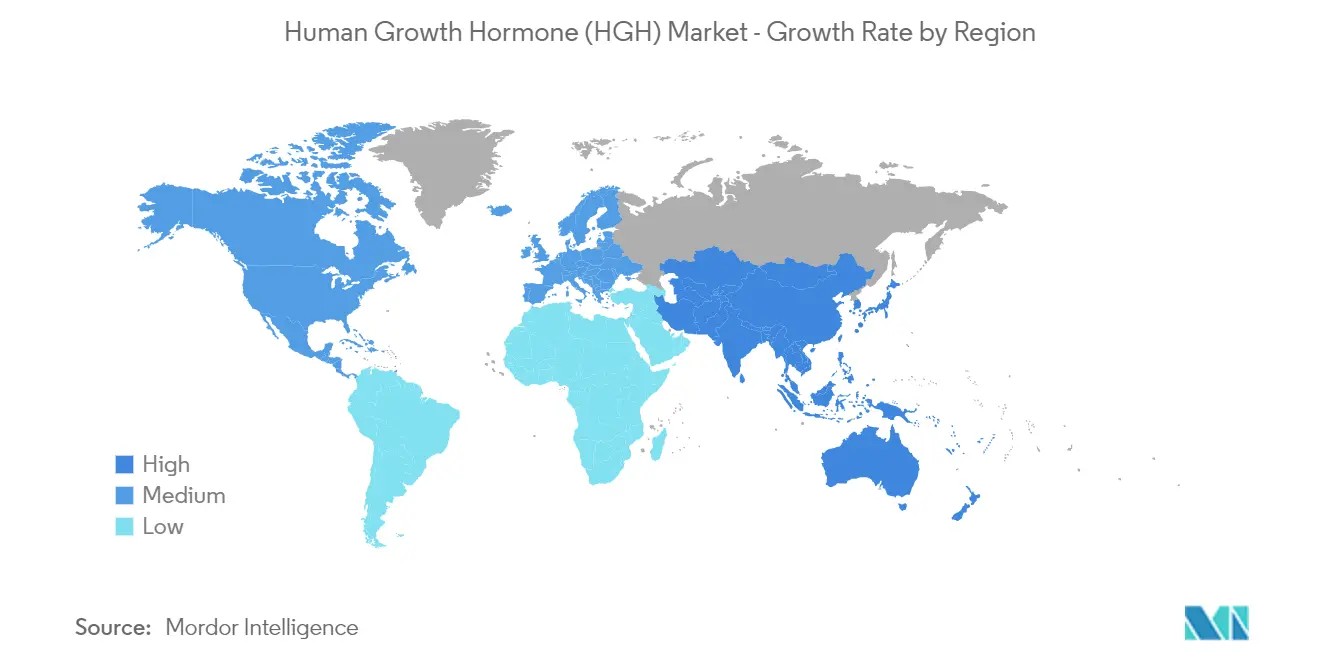Human Growth Hormone Market Size

| Study Period | 2019 - 2029 |
| Base Year For Estimation | 2023 |
| CAGR | 8.61 % |
| Fastest Growing Market | Asia Pacific |
| Largest Market | North America |
| Market Concentration | Low |
Major Players
*Disclaimer: Major Players sorted in no particular order |
Human Growth Hormone Market Analysis
The human growth hormone market registered a market size of USD 4,632.54 million in 2020, and it is expected to reach USD 7,567.74 million by 2026, registering a CAGR of 8.61% during the forecast period, 2021-2026.
According to a research article by Mohamed Hamdy Elkarow et al., published in the Frontiers in Endocrinology Journal November 2020, patients with decreased growth hormone secretion constitute a risk factor for COVID-19 severity, which requires attention toward preventive measures in susceptible individuals.
In addition, patients with Prader-Willi syndrome should take extra precautions to minimize the risk of getting COVID-19. Moreover, Prader-Willi syndrome patients may not show typical symptoms such as a high temperature, and they may also experience a higher-than-normal pain threshold, which may delay the diagnosis of COVID-19.
The major factors driving the market growth include the development of recombinant human growth hormone drugs, rise in pituitary dysfunction cases, and rising off-label use of human growth hormones.
In humans, the growth hormone deficiency is caused when the pituitary gland does not synthesize enough concentration of human growth hormones. This deficiency is treated by administering recombinant human growth hormones by subcutaneous injection. Various genetic disorders such as Prader-Willi syndrome and Turner syndrome may also cause growth hormone deficiency, leading to delayed puberty and shorter-than-average height.
Turner syndrome, also known as congenital ovarian hypoplasia syndrome, occurs when the X chromosome is partially or completely missing in females. According to a research article by Xiaoxiao Cui et al., published in the Intractable & Rare Diseases Research Journal 2018, globally, Turner syndrome (TS) is a relatively common type of human chromosomal aberration that occurs in 1:2,500 live female births.
The human growth hormone helps to stimulate regeneration, reproduction, and growth. Rising use of growth hormones and awareness about growth hormones, which helps in the management of growth hormone deficiency disorders, are boosting the market growth.
Furthermore, most companies are investing in R&D to develop a growth hormone that has fewer side effects and will be a long-acting hormonal therapy. In addition, the rapid development of new novel recombinant human growth hormones is expected to drive the human growth hormone market over the forecast period.
Human Growth Hormone Market Trends
This section covers the major market trends shaping the Human Growth Hormone (HGH) Market according to our research experts:
The Turner Syndrome Segment is Expected to Hold a Significant Market Share Over the Forecast Period
Turner syndrome is a rare chromosomal disorder that affects females. It is characterized by the partial or complete loss of one of the X chromosomes. The symptoms of Turner syndrome include a wide neck and a low or indistinct hairline, a tendency to develop high blood pressure, minor eye problems, drooping of the eyelids, and an under-active thyroid gland.
Individuals with Turner syndrome are at higher risk of severe illnesses from the COVID-19 virus. In addition, Turner syndrome patients often suffer from congenital heart disease, including having a bicuspid aortic valve. Heart disease is an underlying medical condition that can result in severe complications from COVID-19.
According to a research article by Xiaoxiao Cui et al. published in the Intractable & Rare Diseases Research 2018, Turner syndrome (TS) is a relatively common type of human chromosomal aberration that occurs in 1:2,500 live female births. It is highly prevalent in China.
Since Turner syndrome is associated with many complications related to heart, autoimmune disorders, mental health issues, hearing loss, infertility, and pregnancy complications, the demand for treatment involving growth hormones is increasing, which is boosting the market growth.
Increasing awareness about early diagnosis and treatment of Turner syndrome by various public and private organizations is expected to boost the market growth. For instance, non-profit organizations such as Turner Syndrome Support Society United Kingdom, Turner Syndrome Society of the United States, and Turner Syndrome Foundation celebrate 'Turner Syndrome Awareness Month' in February every year and launched a nationwide campaign to spread awareness about the condition.
Furthermore, increasing research and development in the development of effective therapeutics for Turner syndrome (TS) show a positive impact on the market growth. For instance, as per the research study published in the Intractable & Rare Diseases Research 2018, the next generation of treatment for Turner syndrome (TS) will be based on stem cells and regenerative medicine. Thus, considering the above factors, the market is expected to witness significant growth over the forecast period.

North America is Expected to Dominate the Market Over the Forecast Period
The major factors driving the market growth in the United States include increasing research and development activities, favorable reimbursement policies, established healthcare infrastructure, significant government initiatives, and growing healthcare awareness.
As per the Foundation for Prader-Willi Research registry data August 2020, in people with Prader-Willi syndrome, COVID-19 had an impact on access to medical care and therapies due to COVID-19-related restrictions in the United States. In addition, COVID-19 related restrictions also had an impact on temporary access to physical, occupational, speech, and psychological therapies. There was a 60-80% decline in access to Prader-Willi Syndrome-related therapies.
According to a research article by Jessica Bohonowych et al., published in the Genes Journal 2019, Prader-Willi syndrome (PWS) is a rare genetic disorder with an estimated prevalence of approximately 10,000 to 20,000 living individuals in the United States.
As per the American Academy of Pediatrics, growth hormone deficiency is a rare condition that affects less than one in 3,000 to one in 10,000 children in the United States. Recombinant growth hormone has been widely available for chronic renal insufficiency, growth hormone deficiency (GHD), gestational age or intrauterine growth retardation, Turner's syndrome, Prader-Willi syndrome, and cachexia in the United States.
Furthermore, increasing awareness about growth hormone deficiencies and treatment is expected to boost the market growth. For instance, every year, the International Coalition of Organizations Supporting Endocrine Patients (ICOSEP) celebrates Children's Growth Awareness Day to spread awareness about the early diagnosis and treatment of growth hormone disorders.
Increasing research and development activities in the development of effective therapeutics are resulting in the increasing number of pipeline drugs. For instance, in October 2019, Pfizer Inc. and its partner OPKO Health Inc. announced that its Phase III study investigating Somatrogon in pre-pubertal children with human growth hormone met its primary endpoint of non-inferiority to daily somatropin. Thus, owing to the above factors, North America is expected to register growth over the forecast period.

Human Growth Hormone Industry Overview
The human growth hormone market is moderately consolidated, with a few market players controlling a significant market share. Furthermore, there are several active partnerships for the development of more efficacious and long-acting subtypes of human growth hormones. Some of the key market players include AnkeBio Co. Ltd, Eli Lilly and Company, Ferring BV, Novo Nordisk AS, Ipsen SA, Pfizer Inc., Genentech Inc. (Roche), and Teva Pharmaceutical Industries Ltd.
Human Growth Hormone Market Leaders
-
AnkeBio Co. Ltd
-
Eli Lilly and Company
-
Ferring BV
-
Novo Nordisk AS
-
Ipsen S.A.
*Disclaimer: Major Players sorted in no particular order
_Market_landscape.webp)
Human Growth Hormone Market News
In February 2021, Pfizer Inc. initiated a Phase III clinical trial to evaluate the efficacy and safety of somatropin in a cohort of Japanese participants with Prader-Willi Syndrome (PWS).
In October 2020, Erasmus Medical Center, in collaboration with Pfizer, Foundation for Prader-Willi Research, and Prader-Willi Fonds, initiated a Phase III clinical trial to assess the effect of growth hormone treatment (Genotropin) on physical and psychosocial health in adults of 30 years or older with Prader-Willi syndrome.
Human Growth Hormone Market Report - Table of Contents
1. INTRODUCTION
- 1.1 Study Assumptions
- 1.2 Scope of the Study
2. RESEARCH METHODOLOGY
3. EXECUTIVE SUMMARY
4. MARKET DYNAMICS
- 4.1 Market Overview
-
4.2 Market Drivers
- 4.2.1 Development of Recombinant Human Growth Hormone Drugs
- 4.2.2 Rise in Pituitary Dysfunction Cases
- 4.2.3 Rising Off-label Use of Human Growth Hormones
-
4.3 Market Restraints
- 4.3.1 Adverse Effects Associated with Human Growth Hormones
- 4.3.2 Stringent Regulatory Processes
-
4.4 Porter's Five Forces Analysis
- 4.4.1 Threat of New Entrants
- 4.4.2 Bargaining Power of Buyers/Consumers
- 4.4.3 Bargaining Power of Suppliers
- 4.4.4 Threat of Substitute Products
- 4.4.5 Intensity of Competitive Rivalry
5. MARKET SEGMENTATION
-
5.1 By Application
- 5.1.1 Growth Hormone Deficiency
- 5.1.2 Turner Syndrome
- 5.1.3 Idiopathic Short Stature
- 5.1.4 Prader-Willi Syndrome
- 5.1.5 Other Applications
-
5.2 By Distribution Channel
- 5.2.1 Hospitals and Retail Pharmacies
- 5.2.2 Online Pharmacies
- 5.2.3 Other Distribution Channels
-
5.3 Geography
- 5.3.1 North America
- 5.3.1.1 United States (By Application and Distribution Channel)
- 5.3.1.2 Canada (By Application and Distribution Channel)
- 5.3.1.3 Mexico (By Application and Distribution Channel)
- 5.3.2 Europe
- 5.3.2.1 Germany (By Application and Distribution Channel)
- 5.3.2.2 United Kingdom (By Application and Distribution Channel)
- 5.3.2.3 France (By Application and Distribution Channel)
- 5.3.2.4 Italy (By Application and Distribution Channel)
- 5.3.2.5 Spain (By Application and Distribution Channel)
- 5.3.2.6 Rest of Europe (By Application and Distribution Channel)
- 5.3.3 Asia-Pacific
- 5.3.3.1 China (By Application and Distribution Channel)
- 5.3.3.2 Japan (By Application and Distribution Channel)
- 5.3.3.3 India (By Application and Distribution Channel)
- 5.3.3.4 Australia (By Application and Distribution Channel)
- 5.3.3.5 South Korea (By Application and Distribution Channel)
- 5.3.3.6 Rest of Asia-Pacific (By Application and Distribution Channel)
- 5.3.4 Middle-East and Africa
- 5.3.4.1 GCC (By Application and Distribution Channel)
- 5.3.4.2 South Africa (By Application and Distribution Channel)
- 5.3.4.3 Rest of Middle-East and Africa (By Application and Distribution Channel)
- 5.3.5 South America
- 5.3.5.1 Brazil (By Application and Distribution Channel)
- 5.3.5.2 Argentina (By Application and Distribution Channel)
- 5.3.5.3 Rest of South America (By Application and Distribution Channel)
6. COMPETITIVE LANDSCAPE
-
6.1 Company Profiles
- 6.1.1 AnkeBio Co. Ltd
- 6.1.2 EMD Serono Inc.
- 6.1.3 F.Hoffmann-La Roche Ltd
- 6.1.4 Ferring BV
- 6.1.5 Ipsen SA
- 6.1.6 Eli Lilly and Company
- 6.1.7 Novo Nordisk AS
- 6.1.8 Pfizer Inc.
- 6.1.9 Teva Pharmaceutical Industries Ltd
- 6.1.10 Sandoz International GmbH (Novartis AG)
- 6.1.11 Strongbridge Biopharma
- 6.1.12 GeneScience Pharmaceuticals Co. Ltd
- 6.1.13 Sinobioway Hygene Biomedicine Co. Ltd
- 6.1.14 Aeterna Zentaris
- 6.1.15 LG Life Sciences
- *List Not Exhaustive
7. MARKET OPPORTUNITIES AND FUTURE TRENDS
** Subject To AvailablityHuman Growth Hormone Industry Segmentation
As per the scope of the report, the human growth hormone, also known as somatotropin, is a peptide hormone that stimulates growth, cell reproduction, and cell regeneration. The human growth hormone (HGH) market is segmented by application (growth hormone deficiency, Turner syndrome, idiopathic short stature, Prader-Willi syndrome, and other applications), distribution channel (hospitals and retail pharmacies, online pharmacies, and other distribution channels), and geography (North America, Europe, Asia-Pacific, Middle-East and Africa, and South America). The report offers the value (in USD million) for the above segments.
| By Application | Growth Hormone Deficiency | |
| Turner Syndrome | ||
| Idiopathic Short Stature | ||
| Prader-Willi Syndrome | ||
| Other Applications | ||
| By Distribution Channel | Hospitals and Retail Pharmacies | |
| Online Pharmacies | ||
| Other Distribution Channels | ||
| Geography | North America | United States (By Application and Distribution Channel) |
| Canada (By Application and Distribution Channel) | ||
| Mexico (By Application and Distribution Channel) | ||
| Geography | Europe | Germany (By Application and Distribution Channel) |
| United Kingdom (By Application and Distribution Channel) | ||
| France (By Application and Distribution Channel) | ||
| Italy (By Application and Distribution Channel) | ||
| Spain (By Application and Distribution Channel) | ||
| Rest of Europe (By Application and Distribution Channel) | ||
| Geography | Asia-Pacific | China (By Application and Distribution Channel) |
| Japan (By Application and Distribution Channel) | ||
| India (By Application and Distribution Channel) | ||
| Australia (By Application and Distribution Channel) | ||
| South Korea (By Application and Distribution Channel) | ||
| Rest of Asia-Pacific (By Application and Distribution Channel) | ||
| Geography | Middle-East and Africa | GCC (By Application and Distribution Channel) |
| South Africa (By Application and Distribution Channel) | ||
| Rest of Middle-East and Africa (By Application and Distribution Channel) | ||
| Geography | South America | Brazil (By Application and Distribution Channel) |
| Argentina (By Application and Distribution Channel) | ||
| Rest of South America (By Application and Distribution Channel) |
Human Growth Hormone Market Research FAQs
What is the current Global Human Growth Hormone (HGH) Market size?
The Global Human Growth Hormone (HGH) Market is projected to register a CAGR of 8.61% during the forecast period (2024-2029)
Who are the key players in Global Human Growth Hormone (HGH) Market?
AnkeBio Co. Ltd, Eli Lilly and Company, Ferring BV, Novo Nordisk AS and Ipsen S.A. are the major companies operating in the Global Human Growth Hormone (HGH) Market.
Which is the fastest growing region in Global Human Growth Hormone (HGH) Market?
Asia Pacific is estimated to grow at the highest CAGR over the forecast period (2024-2029).
Which region has the biggest share in Global Human Growth Hormone (HGH) Market?
In 2024, the North America accounts for the largest market share in Global Human Growth Hormone (HGH) Market.
What years does this Global Human Growth Hormone (HGH) Market cover?
The report covers the Global Human Growth Hormone (HGH) Market historical market size for years: 2019, 2020, 2021, 2022 and 2023. The report also forecasts the Global Human Growth Hormone (HGH) Market size for years: 2024, 2025, 2026, 2027, 2028 and 2029.
Growth Hormone Industry Report
Statistics for the 2024 Growth Hormone market share, size and revenue growth rate, created by Mordor Intelligence™ Industry Reports. Growth Hormone analysis includes a market forecast outlook to 2029 and historical overview. Get a sample of this industry analysis as a free report PDF download.



